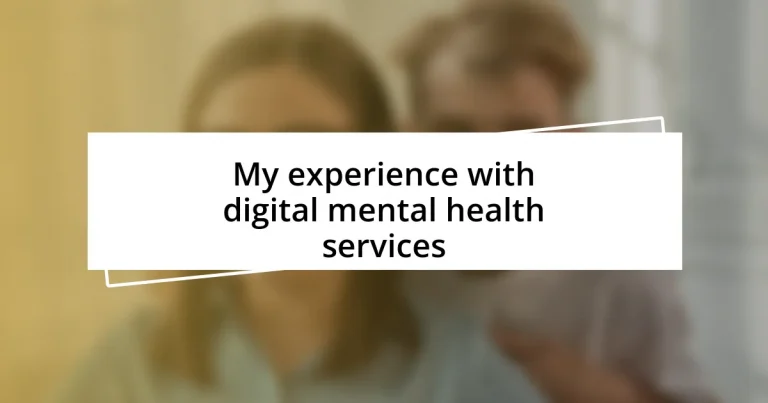Key takeaways:
- The convenience of digital therapy made it easier to open up about personal issues and integrate mental health care into daily life.
- On-demand support and mood tracking features provided immediate relief and deeper self-reflection, enhancing the overall therapeutic experience.
- Challenges included technical issues, lack of non-verbal cues, and the need for self-motivation, but these were balanced by insights gained and personal growth.
- Consistency in scheduling sessions and engaging with community support on platforms proved crucial for making progress and feeling connected in the therapy process.

My journey into digital therapy
I remember the first time I signed up for a digital therapy app—I felt a mix of excitement and apprehension. The thought of speaking with a therapist through my phone seemed revolutionary yet a tad intimidating. Would a virtual connection really feel as supportive as the traditional face-to-face sessions I had experienced before?
As I navigated through the app, I found myself reflecting on how much easier it was to express certain feelings behind a screen. Opening up about insecurities or past experiences felt less daunting; there was an interesting comfort in knowing I was in my own space while discussing deeply personal topics. Have you ever felt that way—like the walls of your home can offer a sense of safety that enhances your ability to share?
Each session brought insights I didn’t anticipate. I often marveled at how the convenience of digital therapy allowed me to explore my mental health on my terms. It became a part of my routine, weaving seamlessly into my life, which is something I struggled to maintain with in-person appointments. I’ve found that this innovative approach not only kept me accountable but also made self-care feel more accessible and less of a chore.

Features that enhance my experience
The most transformative feature for me was the option for on-demand support. There were nights when anxiety would creep in unexpectedly, disrupting my peace. Being able to reach out to a therapist via chat or video at that moment felt like a lifeline. It’s reassuring to know that help is just a few taps away, and it truly made a difference in how I handled those tough moments.
Another aspect I appreciated was the mood tracking feature. I initially thought it would be tedious to log how I felt daily, but in reality, it opened my eyes to patterns I hadn’t noticed before. I began to see connections between my emotions and external factors, leading to deeper discussions with my therapist. It became a powerful tool for self-reflection, helping me articulate my feelings more clearly during our sessions, which ultimately deepened my therapeutic experience.
Lastly, the privacy and anonymity of digital therapy cannot be overstated. I’ll admit that initially, I feared judgment at traditional therapy sessions. But in the digital realm, I felt free to share without fear of being scrutinized. The comfort of engaging in therapy from my cozy spot at home made me more vulnerable and open. This unique combination of safety and accessibility has been a game-changer in my mental health journey.
| Feature | Impact on Experience |
|---|---|
| On-Demand Support | Provided immediate relief during moments of anxiety. |
| Mood Tracking | Revealed emotional patterns that guided deeper discussions. |
| Privacy and Anonymity | Created a judgment-free space for vulnerability and openness. |

Challenges I faced during treatment
There were definitely challenges I didn’t anticipate when I started using digital mental health services. For instance, I remember a particularly overwhelming week where I struggled with connectivity issues. Just as I was about to dive into a difficult topic during a session, my app froze. It was frustrating to feel that nerve-wracking tension build up, only to be interrupted by technical glitches, and it made me question the reliability of this type of therapy.
Here are some challenges I faced:
- Technical Issues: Glitches and connectivity problems disrupted sessions, making it hard to focus.
- Lack of Non-Verbal Cues: Missing out on body language and facial expressions felt isolating at times.
- Self-Motivation: While the convenience was great, I found it sometimes hard to stay disciplined without the structure of in-person appointments.
- Overwhelming Choices: The sheer number of resources and tools in the app made it difficult to know where to start at times, leaving me feeling lost.
Connecting with a therapist through a screen was an adjustment, too. I often missed the physical presence and the subtle nuances of an in-person conversation. There was something about the absence of their non-verbal cues that sometimes left me feeling uncertain about my own emotional expressions. Yet, I also discovered that even in those moments of uncertainty, I could open up in ways I hadn’t expected, which provided me a unique avenue to explore my emotions.

How I measured my progress
Measuring my progress through digital mental health services was a journey full of revelations. I found it helpful to use an app that provided visual progress charts. The first time I saw my mood patterns laid out over weeks, it was a little like looking into a mirror–stark and revealing. I could see not only the ups and downs but also how my coping strategies evolved. Did I expect such a clear picture? Honestly, no, but it became a motivating factor to keep pushing forward.
I also leaned heavily on the journaling feature that many digital platforms offer. Reflecting on my thoughts and feelings regularly turned out to be more than just an exercise; it became a ritual. During particularly challenging moments, I would reread my entries and realize the strength I had discovered. Have you ever felt like your emotions were chaotic? Writing them down helped me untangle that web, making it easier to discuss specific issues with my therapist.
Another insightful method was setting personal goals. At first, I struggled to define what success looked like for me in this environment. But as I started to set small, achievable goals—like practicing mindfulness for 10 minutes daily—I could measure my growth in concrete ways. Each completed task felt like a mini celebration, a reminder that progress doesn’t have to be monumental to be valuable. I still remember the pride I felt when overcoming a day that used to overwhelm me. That sense of accomplishment propelled me forward, turning each small victory into a stepping stone for bigger challenges ahead.

Recommendations for future users
When considering digital mental health services, I highly recommend taking the time to research the platforms available. Not all services are created equal; some may align better with your specific needs. I remember feeling utterly overwhelmed by the choices at first. Each app had its strengths and weaknesses, but I ultimately found one that resonated with me because of its user-friendly design and supportive community features. Have you reflected on what’s most important to you in a service? It’s worth weighing those preferences carefully.
Another tip is to make a commitment to consistency. Initially, I treated sessions like an option rather than a priority. It wasn’t until I adopted a regular schedule that I truly started to see the benefits. I set reminders on my phone, treating each session like an important appointment. Imagine how powerful it feels to engage with your mental health journey regularly, like flipping through a book page by page instead of reading it all at once; slowly and steadily, you uncover so much more.
Lastly, don’t hesitate to reach out for support within the platforms. Many services offer forums or chat features where you can connect with others who understand your journey. I distinctly remember posting in a community forum after a particularly tough week. The responses I received were both comforting and illuminating, making me realize that I wasn’t alone. Engaging with others can enrich your experience, providing you insights and encouragement that can be immensely uplifting. Have you considered how sharing your journey can not only support you but also inspire someone else?














